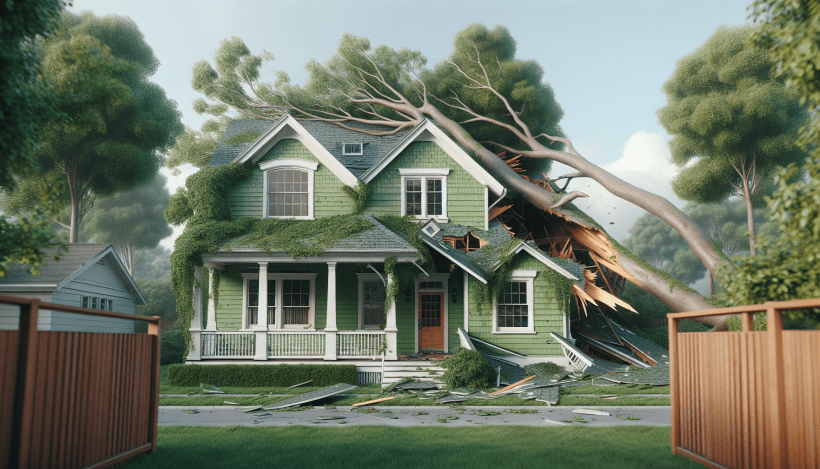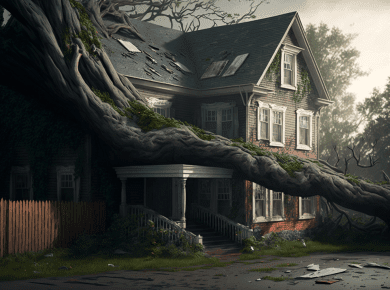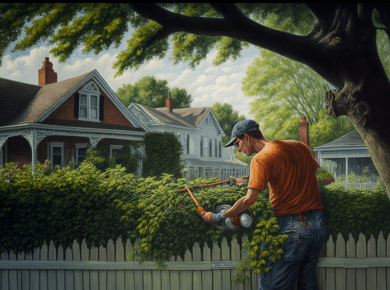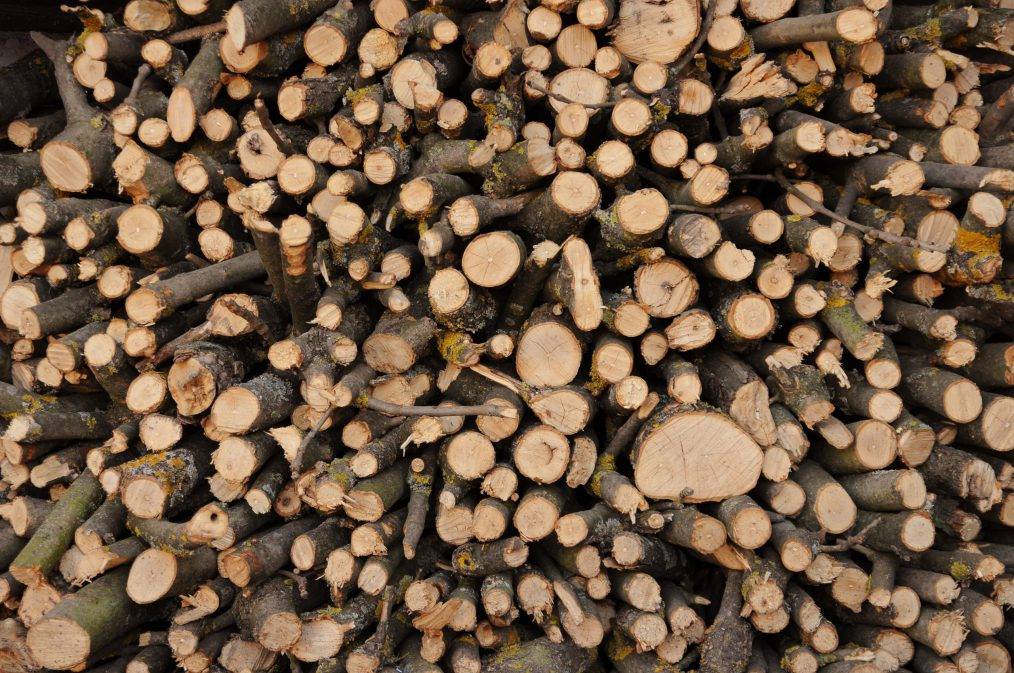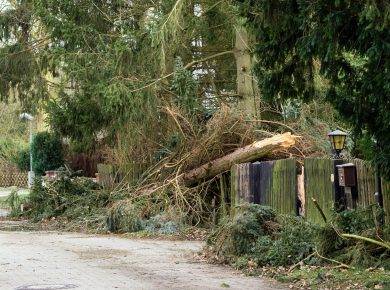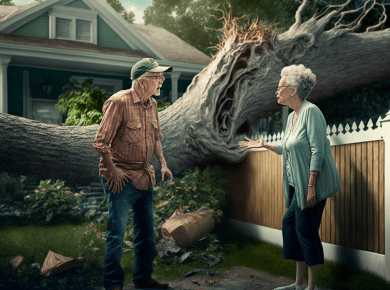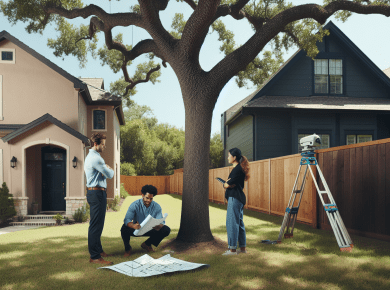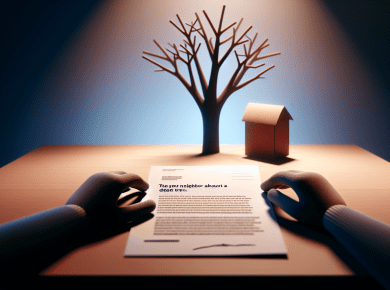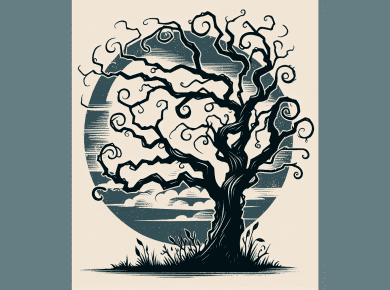Who’s Paying for That Fallen Tree?
Dealing with the mess and stress of fallen trees can be a headache. Let’s break down who’s in charge of cleanup costs when trees decide to go where they aren’t wanted.
Who’s to Blame When Trees Fall?
When a tree crashes down, figuring out who foots the bill isn’t always a clear-cut case. As a rule of thumb, if your tree falls, you’re responsible for picking up the pieces – even if it lands in the neighbor’s yard. Same goes the other way around. Got a tree on your property causing chaos next door? Be ready to pay.
For example, if your neighbor’s gnarly oak topples over onto your prized picket fence, guess what? They’re the ones who need to pull out their wallet to cover the costs. Now, things get tricky when hazardous trees come into play. If you spot a potentially dangerous tree on your neighbor’s property, drop them a written heads-up. If they ignore it and it goes down, you might be able to claim a little something for the hassle.
| Scenario | Who’s Footing the Bill? |
|---|---|
| Your tree falls on neighbor’s yard | You’re covering it |
| Neighbor’s tree falls on your yard | Neighbor’s problem |
Insurance to the Rescue
Got insurance? Time to give it a good look-over. Home insurance usually takes care of tree-related disasters, covering the cleanup and repairs. Sometimes it’s faster and easier to file a claim with your insurance and let them chase down the neighbor for the cost if it’s their tree.
Picture this: your neighbor’s towering pine crashes through your living room. Straight away, contact your insurer. They’ll deal with the repairs and then battle it out with your neighbor’s insurance to recover their money.
| Insurance Type | What’s Covered? |
|---|---|
| Home insurance | Damage, cleanup, repairs from tree falls |
Knowing who’s on the hook and having the right coverage can turn a tree fiasco from a disaster into just another story to tell at the barbecue. For more behind-the-scenes info on tree responsibilities, check out our guides on who’s responsible for fallen tree removal and fallen tree removal tips.
No one plans for trees to make unexpected visits, but now you’re a bit more prepared if one does.
Who’s to Blame When a Tree Falls?
When a tree from your neighbor’s yard topples into your space, figuring out who’s on the hook for the damage can get tricky. Here’s a down-to-earth look at the difference between nature’s fury and human negligence, the usual bill for removing a fallen tree, and the never-ending importance of keeping your trees in tip-top shape.
Mother Nature vs. Human Goof-ups
What caused the tree to fall spills the beans on who’s liable. If it was a natural event like a big storm, lightning, earthquake, or flood – stuff no one can control – your neighbor usually gets off the hook. But if that tree was a goner: dead, sick, or rotting and your neighbor knew it but did nada, they might be on the line for your smashed fence or dented car (Ergeon).
Tree Removal: What’s It Gonna Cost?
When the tree hits the ground, so does your money. We’re talking an average of $1,000 to get that thing out of your yard in 2023. But prices jump around depending on the tree’s size, type, how easy it is to reach, and what gadgets the pros need. Check out this cost chart:
| Tree Size | Cost Range |
|---|---|
| Small (less than 30 ft) | $150 – $500 |
| Medium (30-60 ft) | $300 – $1,000 |
| Large (over 60 ft) | $1,000 – $2,000+ |
Need more details? Peek at our deep dive on how much to cut down a tree.
Why Tree TLC Matters
Keeping trees in shipshape can save you a whole lot of headaches. Regular check-ins for signs of disease, decay, or any “uh-oh” branch situations are key. Giving your tree a professional trim now and then can nip potential problems in the bud. It’s a good idea to buddy up with a certified arborist who can offer sage advice and ensure your trees stay healthy (Ergeon). For more handy tips on tree care, check out who is responsible for cutting overhanging tree branches and who is responsible for fallen tree removal.
Taking good care of your trees not only boosts your property’s value but also keeps the neighborhood looking sharp and safe. Trees might be the silent giants of your yard, but they do plenty to keep things lively and green.
Trees: More Than Just a Pretty Face
Sure, trees look nice, but they do a lot more than just sit there being green. They’re like the Swiss army knives of nature—boosting property value and making life better in ways you might not expect.
Why Homes With Trees Sell Better
First up, let’s talk money. Trees can jack up your home’s worth. How? They make your place look inviting and cozy, the type of place where folks want to live. When buyers see a house with well-kept trees, they’re more likely to think “home sweet home” and not just “house.”
| Type of Tree | Average Bump in Property Value (%) |
|---|---|
| Deciduous Trees | 10 – 15 |
| Evergreen Trees | 7 – 12 |
| Flowering Trees | 5 – 10 |
So, what’s the takeaway? Plant the right kinds of trees and take care of them—they’re like green piggy banks growing in your front yard. Keep them healthy, and your wallet will thank you when it’s time to sell. Want the full scoop? Chat with a certified arborist. Oh, and if your neighbor’s tree crashes the party on your property, check out who handles that mess.
Green Benefits: Good for You and the Planet
Trees aren’t just good for your wallet; they’re good for the world. They cool things down in the summer—hello, lower AC bills. And they clean the air by taking in carbon dioxide and other yucky gases, making it easier for you to breathe.
But that’s not all. Trees give a major boost to your mental health too. Imagine it—studies show spending time around trees can lift your mood, dial down stress, and make you feel better mentally. Plus, they’re a hit with local critters, helping birds, bees, and other wildlife thrive, which is a win for biodiversity and soil quality.
Curious about how tree trouble with neighbors works? Dive into trees on property lines and fallen tree clean-up. Regular check-ups and care will keep your trees in top shape and help you avoid any “my tree, your tree” squabbles with the folks next door.
So there you have it. Trees aren’t just eye candy—they’re valuable, eco-friendly, and good for your brain. Keep them happy, and they’ll keep you happy too.
Handling Neighbor Disputes Over Fallen Trees
When it comes to dealing with a neighbor’s tree that decides to drop by unannounced on your property, the situation can get sticky. But don’t worry—here’s your go-to guide for navigating these leafy dramas.
When Storms Knock Trees Down
Storms can uproot even the mightiest tree. But who ends up paying for the damage? It depends on the tree’s condition before the storm threw its weight around. If your neighbor’s tree was in tip-top shape, then usually, they aren’t on the hook for damages. However, if the tree was rotting or dead before the gusts kicked in, your neighbor might have to pay up.
To make things smoother, talk things out with your neighbor. Snap some pics and grab a statement or two about the tree’s health before Mother Nature threw a fit. It’s all about having your facts straight.
| Tree’s Condition Before Storm | Homeowner’s Bill |
|---|---|
| Healthy | Not Responsible |
| Sick/Decayed | Maybe Responsible |
| Dead | Maybe Responsible |
Dealing with Insurance Claims
So, a tree crashes into your home, and now you’re staring at a hole in your roof. First stop? Your insurance policy. Most homeowner policies cover these tree-invading scenarios. File a claim with your insurer to get those repairs rolling (Merchants Insurance Group).
But here’s a lesser-known twist: after your insurer settles your claim, they might go after your neighbor’s insurance to get reimbursed (TexasLawHelp.org). It’s called subrogation, and it means your insurer plays detective to see if your neighbor should foot the bill instead.
Want more info on these tree-related headaches? Peek at our guides on who handles a fallen tree and how to get rid of one. Knowing the ins and outs of your insurance can save you a lot of stress when the branches start flying.
Dealing with Neighbor Disputes
Got a tree vicariously invading your space from the neighbor’s yard and causing mayhem? It’s a tricky situation, but don’t stress. Let’s break down how to figure out who’s responsible and what you can do about it.
Sorting Out Responsibility
Here’s the scoop: who’s responsible depends on where that troublesome tree falls and why. Generally, if your neighbor’s tree decides to execute a tumble onto your property, they should foot the bill for the mess. Here’s a quick rundown:
| Situation | Who’s Responsible? |
|---|---|
| Neighbor’s Tree Topples onto Your Property | Neighbor pays for the cleanup and repairs |
| Your Healthy Tree Crashes onto Neighbor’s Place because of a Storm | You’re typically off the hook |
| Neighbor’s Dead Tree Collapses onto Your Property | Neighbor likely owes you for damages |
Keep tabs on those trees skirting your property line. Snap some pics or jot down notes about their condition. If a tree seemed healthy and then a big storm brought it down, you might be in the clear for any damages.
Taking Legal Steps
So, a neighbor’s tree has wreaked havoc. What now? Well, your homeowners’ insurance policy is usually your best friend here. It generally covers damage from fallen trees. Filing a claim can streamline things—you get the help you need right away, and the insurance folks will go after your neighbor for reimbursement. Win-win, right?
If Mother Nature is to blame (think freak storm), who pays can hinge on the tree’s condition beforehand. A healthy tree that gets knocked down by a storm isn’t quite your fault. But if that tree was dead or clearly dying? Then your neighbor likely owes you (TexasLawHelp.org).
Whether it’s your tree damaging their house or their tree smashing into yours, insurance policies will often be the deciding factor. Read the fine print of your policy and theirs, too. For more info, check our detailed guide on who is responsible for fallen tree removal.
Keeping the Peace
Make it a habit to talk with your neighbors about the trees lining your properties. A friendly chat can nip potential disputes in the bud. Regular tree maintenance and clear communication can save everyone a headache. Get ahead of these issues, and you might just keep that neighborly peace.
